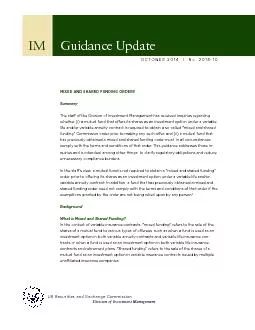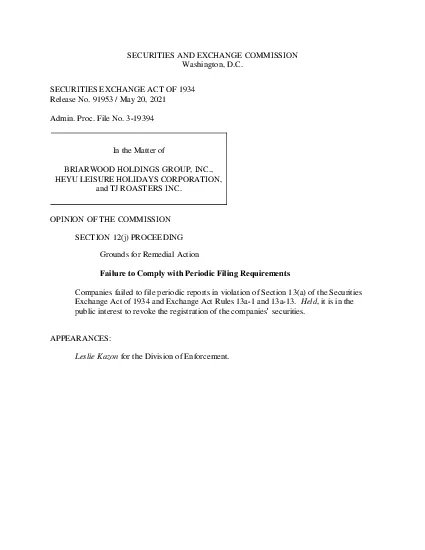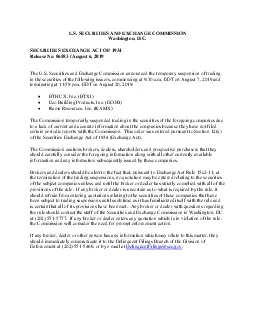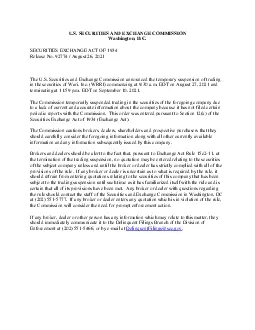PDF-US Securities and Exch
Author : pamella-moone | Published Date : 2015-08-11
ange Commission MIXED AND SHARED FUNDING ORDERS Summary The staff of the Division of Investment Management has received inquiries regarding whether i a mutual fund
Presentation Embed Code
Download Presentation
Download Presentation The PPT/PDF document "US Securities and Exch" is the property of its rightful owner. Permission is granted to download and print the materials on this website for personal, non-commercial use only, and to display it on your personal computer provided you do not modify the materials and that you retain all copyright notices contained in the materials. By downloading content from our website, you accept the terms of this agreement.
US Securities and Exch: Transcript
ange Commission MIXED AND SHARED FUNDING ORDERS Summary The staff of the Division of Investment Management has received inquiries regarding whether i a mutual fund that offers its shares as an inve. LADNROGN2011121121228 In exerci se of the powers conferred by section 30 of the Securities and Exchange Board of India Act 1992 15 of 1992 the Board hereby makes the following Regulations to ame nd the Securities and Exchange Board of India Registr B NASDAQ traded securities simply append the special code after root symbol brPage 7br Option Symbol Options Symbol represents four different characteristics Underlying Instrument Put or Call Expiration Month Strike Price Example MSQJG MSQ By Vishal Shah. Synopsis. Introduction & History . of . Buy . Back Provisions;. Objectives/Advantages of Buy Back;. Modes of Buy Back;. Sources of Buy Back;. Conditions for a Buy back;. Restrictions on Buy Back;. September . 2011 . . Who are . Catley. . Lakeman. ?. Founded July 2008. Team . of. 7 people. FSA . authorised. securities and futures firm. Outsourced origination and distribution business that sells and supports Private Placement . PROF. YEMI OSINBAJO, SAN. CREDIT THE LIFEBLOOD . MODERN ECONOMIES DEPEND CONSIDERABLY ON THE FREE AND ADEQUATE FLOW OF CREDIT.. EASY REALISATION OF CREDIT IS CRUCIAL TO CONFIDENCE IN LENDING. FAILURE OF RULES OR ADMINSTATION OF JUSTICE IS A MAJOR ISSUE . Securities and Investments. 1. Regulating the Securities Industry. 2. Regulations (continued). 3. Regulations (continued). 4. Regulations (continued). 5. State Regulations. Texas State Securities Board. Securities Market Association The Securities Market Association is a cooperation body established in December 2006 by the Confederation of Finnish Industries EK, the Central Chamber of Commerce of F If you are a financial advisor and find yourself in a spot of legal trouble, you will need the help of a lawyer. How do you choose the right lawyer? In this blog we list some of the ways in which you can have access to the best lawyer ANDEXCHANGECOMMISSIONWashingtonDCSECURITIESEXCHANGEACTOF1934ReleaseNo91953/May202021AdminProcFileNo3-19394In the Matter of BRIARWOOD HOLDINGS GROUP INC HEYU LEISURE HOLIDAYS CORPORATION and TJ ROASTER Washington DC SECURITIES EXCHANGE ACT OF 1934 Release No 86583/ August 6 2019The US Securities and Exchange Commission announced the temporary suspension of trading in the securities of the following Washington DC SECURITIES EXCHANGE ACT OF 1934 Release No 92774 / August 26 2021The US Securities and Exchange Commission announced the temporary suspension of trading in the securities of Wari IncWRRI Washington DC SECURITIES EXCHANGE ACT OF 1934 Release No 91929/ May 18 2021The US Securities and Exchange Commission announced the temporary suspension of trading in the securities of Echo Therapeutic 313029282726253028252428312322212028191817182526212816291522231825182914is a financial instrument that represents evidence of an ownership interest in an asset the difference is they have been created Share0 The term share means a share of stock in a corporation a share or other unit of benex00660069cial interest in a trust or Foreign Issuers foreign private issuer may comply with
Download Document
Here is the link to download the presentation.
"US Securities and Exch"The content belongs to its owner. You may download and print it for personal use, without modification, and keep all copyright notices. By downloading, you agree to these terms.
Related Documents














